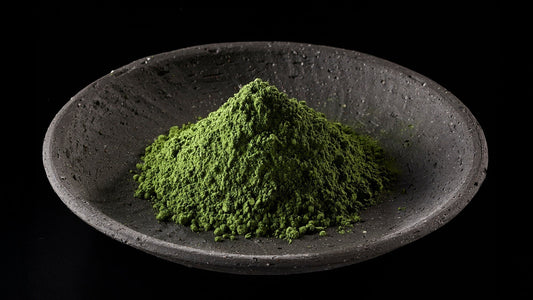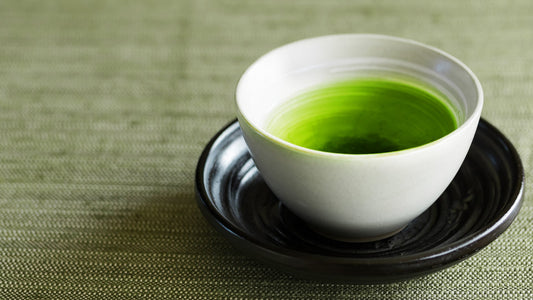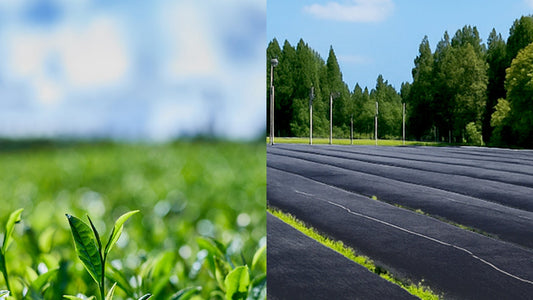The first point is simple, yet unsettling: the vivid, glowing green often associated with matcha can be manufactured. Many still believe that “bright green = high quality” and “deep umami = premium.” The truth is that both can be easily engineered.
Matcha referred to as “Ceremonial grade” is generally defined as follows:
・Produced from the first flush (ichibancha), using only the tender shoots picked in May
・Tea plants are shaded with a covering for more than twenty days before harvest
・After harvesting, the leaves are slowly ground into a fine powder using a traditional stone mill
By contrast, what is commonly sold abroad as culinary or cooking grade is typically:
・Second or third flush
・Short shading, or none at all
・Machine-milled, faster but coarse, dulling texture and aroma
These differences shape the tea’s fragrance, flavor, and texture. Yet both color and taste can be manipulated.
How Color and Umami Are Engineered

When tea plants are shaded for more than twenty days, photosynthesis is altered. Chlorophyll, the green pigment, and theanine, an amino acid, both increase, producing a deeper color and a smoother taste. This is the natural order.
But chemical fertilizers push these effects even further:

・Nitrogen fertilizers boost theanine and amplify umami
・Potassium sulfate adds gloss, deepens green, and enhances sweetness
・Ammonium phosphate stimulates roots and increases theanine (not permitted in organic farming)
Thus, vivid color and strong umami can be manufactured. Judging matcha by color alone is risky.
The use of chemical fertilizers has certain advantages, yet it comes at a steep cost. Excessive application weakens the leaves and makes them more vulnerable to pests. An increase in pests leads to a heavier reliance on pesticides. Modern pesticides are designed to stick even through rain, meaning that once applied, they remain. To protect the fragile leaves, more chemicals are added, and the cycle continues.

Because culinary matcha is often produced from multiple flushes, chemical inputs and pesticides are applied almost year-round.
Why Organic Matters Most
What many don’t realize is that tea leaves are never washed and processed immediately. This is to preserve their natural freshness, aroma, and flavor.
With sencha, only the compounds that dissolve in hot water are consumed. With matcha, the powdered leaf itself is ingested, which means that everything contained in the original leaf goes directly into your body.

Which is why, no matter what the label claims, even if it reads “ceremonial,” if the soil has been hardened and the tea bushes weakened by years of heavy chemical fertilizers and pesticides, PHENIMAX cannot regard that tea as truly first class.
Without organic cultivation, there can be no genuine peace of mind. This principle is the foundation on which PHENIMAX stands firm.
The True Meaning of Grades: Focus on Craft, Not the Name
At PHENIMAX, only first flush leaves are used, and every leaf is grown organically. No second flush is ever harvested; once the first flush is picked, the bushes are left to rest and regain strength for the following year.

Through summer, we weed by hand and nurture the soil naturally—sometimes even tasting it to gauge its health.
This is why PHENIMAX fields have soft, living, fluffy soil.
 In Japan, there is no official standard for “ceremonial” and “culinary.” In practice, ceremonial usually refers to first-flush leaves, long shading, and stone milling, while culinary refers to later flushes with shorter shading, often machine-ground.
In Japan, there is no official standard for “ceremonial” and “culinary.” In practice, ceremonial usually refers to first-flush leaves, long shading, and stone milling, while culinary refers to later flushes with shorter shading, often machine-ground.
But color alone is not proof of quality. The true markers are harvest timing, shading, milling, and above all, organic cultivation.
Who Defines “Value”?
In the days of Nobunaga, Hideyoshi, and Sen no Rikyū, the value of tea was not in the drink—which vanished as soon as it was consumed—but in the ritual and utensils. A tea bowl declared “splendid” by a master could be worth more than land itself.

Even today, if a grand master praises a matcha, its value is accepted—even if it is non-organic. Words, not substance, still define much of its worth.
PHENIMAX stands against this. For us, value must come not from who proclaims it, but from how it is created: first flush, proper shading, stone milling, organic cultivation, and healthy soil.
PHENIMAX’s Promise: Transparency Over Color
・Cultivation: Fully organic and pesticide-free, nourished only with food-safe inputs that sustain the natural cycle of soil and microbes.
・Shading: More than twenty days, drawing out the tea’s natural sweetness and aroma.
・Harvest: First flush in May, after which the bushes are allowed to rest and regain strength for the following year.
・Milling: Carefully stone-milled to a fine powder, with low heat to preserve both fragrance and mouthfeel.
・Fields: Located deep in remote mountain valleys, beyond the reach of roads and untouched by pollution.
Packaging & Storage:
Matcha deteriorates quickly. Even the finest matcha loses its fragrance when exposed to oxygen and high temperatures. Refrigeration can also be risky, since nearby food odors transfer unless the tea is double-sealed. PHENIMAX matcha is carefully packed in single-serve portions and kept in dedicated tea refrigerators until the moment of shipping.

This ensures that you can enjoy the finest matcha at its peak, every time.

We do not rely on labels or nominal “grades.” PHENIMAX’s value is defined by responsibility for every step, from the vitality of the field to the bowl in your hands. A vivid green color can be manufactured, but the health of the soil cannot be fabricated. And because matcha is consumed in its entirety, everything within the leaf is taken fully into the body.
Authentic matcha is defined not by its color, but by its process. At PHENIMAX, we take responsibility for every stage of that process.
In conclusion, the choice of matcha should not depend on another’s recommendation. It should be guided by your own conviction, careful research, and thoughtful selection. This is especially vital because matcha is a tea in which the entire leaf is consumed.
Regrettably, Japan ranks among the world’s top three countries in pesticide use per hectare, together with China and South Korea. This reality is one of the reasons PHENIMAX established its fields in remote mountain regions, far removed from such intensive practices.










